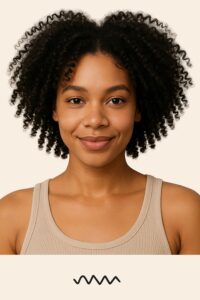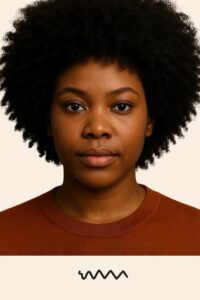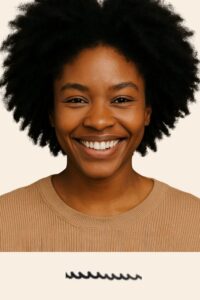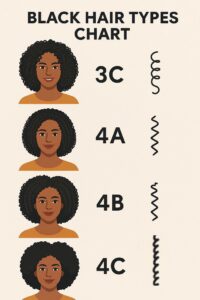Afro Hair Types: A Complete Guide to 4A, 4B, and 4C Hair
October 1, 2025 by
avrupahairtransplant
Afro hair is one of the most unique and celebrated hair textures in the world. Defined by its tightly coiled curl patterns, natural volume, and remarkable versatility, it represents both a biological wonder and a cultural symbol of pride.
But while Afro hair is celebrated for its beauty, it is also prone to specific challenges such as dryness, shrinkage, and fragility — making knowledge of your exact hair type essential. Whether you want to style it naturally, maintain healthy growth, or explore restoration options, understanding Afro hair types is the foundation of good care.
This guide goes beyond the surface. We’ll explore the biology of Afro hair, the differences between 4A, 4B, and 4C hair types, the best care routines, common misconceptions, cultural history, and even modern solutions like Afro hair transplants.
What Is Afro Hair?
Afro hair, sometimes called a ‘fro, refers to hair characterized by tight curls or coils that grow upward and outward rather than down. This is due to the unique shape of Afro hair follicles, which are elliptical or curved, unlike the round follicles of straight hair.
This shape makes Afro hair structurally different in three key ways:
- Curl Pattern: Curls may be spiral (S-shaped) or angular (Z-shaped).
- Shrinkage: Afro hair may appear 50–80% shorter than its actual length when dry.
- Porosity & Dryness: Oils have a harder time traveling down coiled strands, making hair ends drier and more fragile.
What Makes Afro Hair Unique?
Unlike straight or wavy hair, Afro hair grows in a spiral or zig-zag pattern due to the shape of the hair follicle. While straight hair follicles are typically round, Afro hair follicles are oval or elliptical. This shape produces tighter curls and gives Afro hair its distinct volume and density.
Key characteristics include:
-
Tight curl patterns ranging from soft waves to very tight coils.
-
Shrinkage, where hair looks shorter than its actual length due to curl tightness.
-
Dryness, since natural oils (sebum) travel less efficiently along tightly coiled strands.
-
High versatility, allowing countless styling options from protective styles to natural looks.
Characteristics of Afro Hair
- Tight Curl Pattern: Coils vary from loose spirals to tiny, spring-like coils.
- Natural Volume: Coils give Afro hair unmatched fullness and body.
- Porosity: Afro hair tends to be highly porous, absorbing water and products quickly but losing moisture just as fast.
- Dryness & Breakage: Brittle ends are common due to poor oil distribution.
- Growth Direction: Hair often grows outward and upward, giving the characteristic Afro shape.
- Shrinkage: Length appears much shorter because of curl tightness.
Andre Walker Types of Afro Hair: 4A, 4B, 4C
The Andre Walker Hair Typing System is the most widely recognized classification of hair types. According to this system Afro hair is generally categorized as Type 4 hair which is the tightest curl category, ranging from fine and soft to wiry and coarse. It is prone to shrinkage and dryness but is incredibly versatile for styling.
Within Type 4, there are three subtypes:
4A Hair: Defined Coils

- Features well-defined, springy, S-shaped curls.
- Texture is dense but retains moisture better than other Type 4 subtypes. Use leave-in conditioners and sealing oils.
- Shrinkage is moderate (up to 70%).
- Common challenge: frizz and tangling.
- Great for wash-and-go looks and twist-outs.
Care Tip: Use moisturizing creams and leave-in conditioners. The “wash-and-go” method works well with this type, but sealing with oils like jojoba or olive helps prevent dryness.
4B Hair: Z-Shaped Strands

-
Strands form sharp angles resembling a zigzag “Z” shape rather than a curl.
-
Hair is fluffy, less defined, and more prone to dryness.
-
Shrinkage can reach up to 75%.
- Needs heavy moisturizing and stretching (banding, braiding) to reduce tangles.
-
Fragile ends and breakage
- Works well with twist-outs, braid-outs, and protective styles.
Care Tip: Keep hair stretched using banding, braids, or African threading. Avoid excessive heat — this type is prone to thinning at the ends.
4C Hair: The Tightest Coils

-
Very densely packed tight coil with little visible definition.
-
Shrinkage can reach 80% or more.
- Can be soft or coarse, with high density.
-
Hair is delicate, highly porous, and requires extra moisture.
-
Common challenge: breakage, shrinkage, and difficulty retaining length.
- Excellent for locs, twists, braids, and wigs.
Care Tip: Deep condition weekly, sleep with silk or satin caps, and use the LOC method (Liquid, Oil, Cream) to lock in hydration.
Common Challenges of Afro Hair
Afro hair is strong and beautiful, but its structure makes it more vulnerable to certain issues:
-
Dryness: Coils prevent natural oils from spreading evenly, leading to dryness.
-
Shrinkage: While natural, it can make hair length appear much shorter than it is.
-
Breakage: Fragility at the ends makes hair prone to splitting.
-
Scalp Issues: Dry scalp, dandruff, or buildup from heavy products.
-
Tangles and Knots: Curls interlock easily, requiring careful detangling.
Myths About Afro Hair
Many myths surround Afro-textured hair. Let’s clear up the most common ones:
- “Afro hair doesn’t grow long”
Truth: Afro hair grows at the same average rate (about half an inch per month) as other hair types, but shrinkage makes length less visible. - “Afro hair is too strong to break”
Truth: Despite its density, Afro hair is actually the most fragile hair type due to its bends and fewer cuticle layers. - “Grease and heavy oils keep Afro hair healthy”
Truth: Heavy products may clog pores and weigh hair down. Lightweight, natural oils and water-based products work better.
Caring for Afro Hair
1. Moisturizing Is Essential
-
Use water-based leave-in conditioners, creams, and oils like shea butter, coconut oil, or jojoba oil.
-
The LOC method (Liquid, Oil, Cream) helps lock in moisture.
2. Gentle Cleansing
- Use sulfate-free shampoos or cleansing conditioners to avoid stripping natural oils.
- Co-wash or use mild shampoos weekly or biweekly.
3. Protective Styling
- Braids, twists, cornrows, and wigs protect hair from daily manipulation.
- Avoid overly tight styles to prevent traction alopecia.
4. Night Protection
- Use satin/silk bonnets or pillowcases to reduce friction.
5. Avoid Heat & Harsh Chemicals
- Minimize flat irons, relaxers, and bleaching to protect fragile strands.
6. Scalp Health
-
Regular scalp massages stimulate blood circulation and promote growth.
-
Keep scalp clean and free from buildup.
- Detangle with wide-tooth combs or fingers when hair is damp and conditioned.
Afro Hair Styling
One of the most remarkable things about African hair is its styling versatility. Because of its natural volume, density, and curl patterns, it allows for a wide range of creative styles — from traditional looks with cultural roots to modern fashion-forward statements.
Popular Afro Hair Styling Options:
-
Protective Styles: Braids, twists, locs, cornrows, and bantu knots reduce daily manipulation while maintaining length.
-
Natural Styles: Wash-and-go looks, twist-outs, and frohawks showcase the natural curl definition of 4A, 4B, and 4C hair.
-
Heat-Free Stretching: Banding, threading, and African braiding help reduce shrinkage without damage.
-
Updos & Puffs: High puffs, buns, and Afro updos create elegant yet low-maintenance styles.
Styling Tips for Healthy Afro Hair:
-
Always style on moisturized, detangled hair to minimize breakage.
-
Rotate protective styles and avoid tension-heavy braids to prevent traction alopecia.
-
Use accessories like satin scrunchies or silk wraps to preserve hair health.
Why Knowing Your Hair Type Matters?
Understanding your hair type can help you:
-
Choose the right products (moisturizers, oils, shampoos).
-
Select protective styles that won’t cause traction alopecia.
-
Improve growth by minimizing breakage.
-
Find tailored hair restoration options if needed (such as Afro hair transplant, which requires curl-aware surgical techniques).
How to Identify Your Afro Hair Type (Even if Short)
-
Step 1: Gently pull a strand of hair under good lighting.
-
Step 2: Look at the curl pattern — S-shape, Z-shape, or no visible definition.
-
Step 3: Compare shrinkage and coil size to 4A, 4B, or 4C charts.
If hair is very short, allow at least one inch of growth before analyzing, or consult a hair care specialist for an accurate classification.
Black Hair Types Chart

Afro Hair and Hair Loss
Afro hair can be vulnerable to traction alopecia (hair loss from tight styles) and chemical damage (relaxers, straighteners). In addition, studies show that African hair often has lower follicle density than Caucasian or Asian hair, which can make hair loss more visible.
Can You Get a Hair Transplant with Afro Hair?
Yes, individuals with Afro-textured hair can undergo hair transplant surgery, but it requires special expertise. The unique curl pattern of African American hair begins below the scalp, meaning follicles are curved, not straight. This makes extraction and implantation more complex compared to Caucasian or Asian hair.
Key Considerations for Afro Hair Transplants:
-
Specialist Surgeons: Only surgeons trained in Afro hair biology can achieve natural results.
-
Techniques Used: FUE (Follicular Unit Extraction) and FUT can both be used, but tools and angles must be adapted to account for curl curvature.
-
Density Illusion: Afro hair creates more coverage with fewer grafts due to its natural volume, but careful planning is essential.
-
Scarring Risks: Because of follicle curvature, there is a slightly higher risk of scarring if performed by an inexperienced surgeon.
For anyone considering restoration, consulting with a clinic experienced in Afro hair transplants is vital. When done properly, results can be natural, permanent, and life changing.
Cultural and Social Dimensions
Afro hair is more than biology; it’s culture. Hairstyles such as braids, locs, and cornrows have deep African roots, historically signalling tribal identity, social status, and spirituality.
Today, the natural hair movement has reframed Afro hair as a symbol of pride and empowerment. Yet challenges remain, a study in Harvard Business Review, 20231 show Black women’s natural hair is still judged as “unprofessional” in workplaces, leading some to feel pressured into chemical straightening. The fight against hair discrimination continues, with legislative measures like the CROWN Act2 in the U.S. pushing for equality.
Bottom Line
Afro hair — whether 4A, 4B, or 4C — is a crown of heritage, beauty, and resilience. By understanding its structure, challenges, and care needs, anyone can maintain healthy, thriving curls. Beyond styling, Afro hair is a cultural expression and a movement of self-love and empowerment.
Embrace it, protect it, and let it grow naturally — because Afro hair is not just hair, it’s history, science, and identity woven into every strand.
FAQs
What are the different types of Afro hair?
Afro hair is categorized as Type 4 in the hair typing system, with three main subtypes: 4A (defined coils), 4B (Z-shaped strands), and 4C (tightest coils). Each type has unique texture, curl pattern, and care needs.
What is 4A, 4B, or 4C hair?
These are subtypes of Type 4 Afro hair. 4A has loose S-shaped coils, 4B forms zigzag Z-shaped strands, and 4C features the tightest, most fragile coils with significant shrinkage. Care routines differ for each subtype.
Is 3C hair Afro hair?
3C hair is curly but not typically classified as Afro hair. It has tight corkscrew curls with more definition and less shrinkage than Type 4 hair. Afro hair usually falls under the Type 4 category with tighter coils.
What is Type 4 Afro hair?
Type 4 Afro hair is coily, kinky hair with tightly packed curls. It includes 4A, 4B, and 4C textures, ranging from springy coils to dense, fragile strands. Type 4 hair requires consistent moisture and protective styling to maintain health.
Do I have 3C or 4A hair?
3C hair has defined corkscrew curls with less shrinkage, while 4A hair forms tighter, S-shaped coils with more shrinkage. If your curls are looser and more defined, you likely have 3C. Tighter spirals indicate 4A.
Can a white person have 4C hair?
Yes, hair type is determined by follicle shape, not ethnicity. While 4C hair is most common in people of African descent, individuals of other backgrounds may naturally have tightly coiled, 4C-like hair if their follicles produce that curl pattern.
What is 5C hair?
“5C hair” is not an official category in the Andre Walker system. It’s an informal term sometimes used online to describe extremely dense, tightly coiled textures beyond 4C, but scientifically, hair typing stops at 4C.
Why is African hair curly?
African hair is curly due to the elliptical shape of the follicles and asymmetry in the hair bulb. These structural traits cause strands to bend, coil, or zigzag as they grow, producing the distinctive curl patterns of Afro-textured hair.
References:
- Harvard Business Review (2023): How Hair Discriminations Affects Black Women at Work
- ClinicAdvisor®: Afro Hair Types
-
The CROWN Act Official Website: The Official Campaign of The CROWN Act Led by the CROWN Coalition
Note: Some hair type images in this guide were generated using AI to provide clear visual representations. They are for illustrative and educational purposes only
Written By
avrupahairtransplant
Avrupa Hair Transplant Clinic, Istanbul’s trusted name since 2006, transforms hair restoration with cutting-edge techniques like FUE, DHI, and Sapphire, crafting natural, lasting results. With over 40,000 success stories and a collection of international awards, Avrupa blends innovation with artistry, delivering personalized care that redefines confidence for clients worldwide.